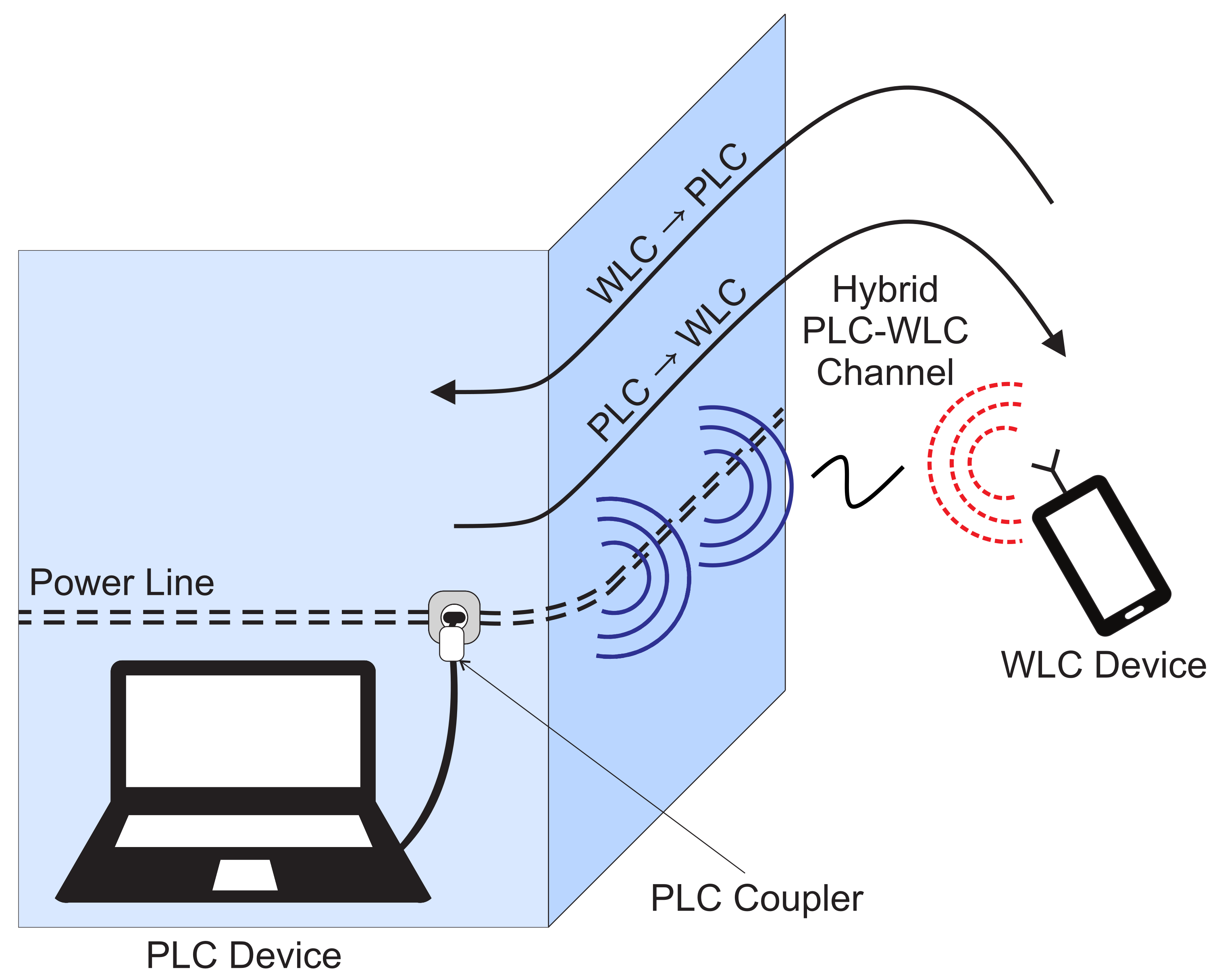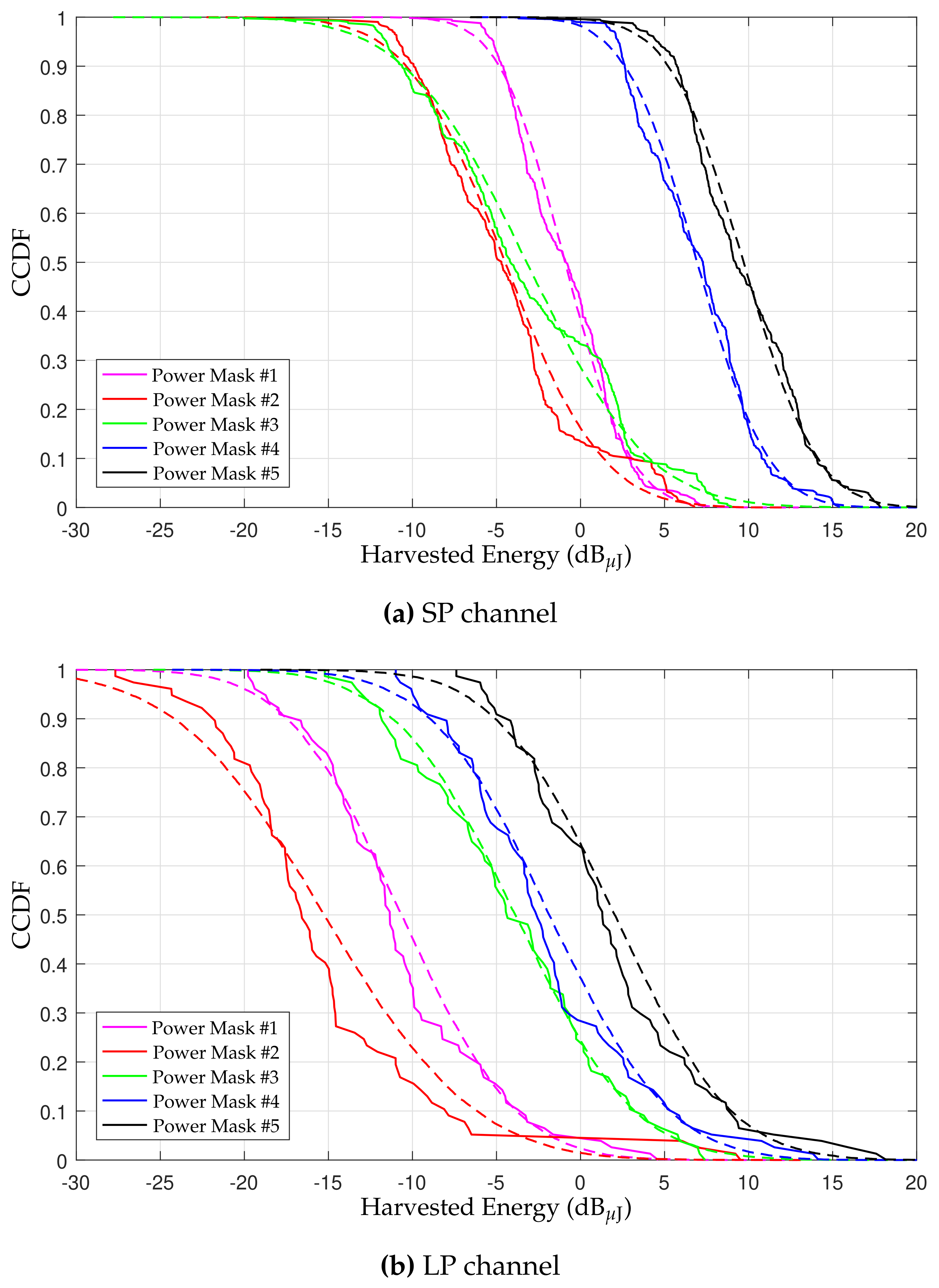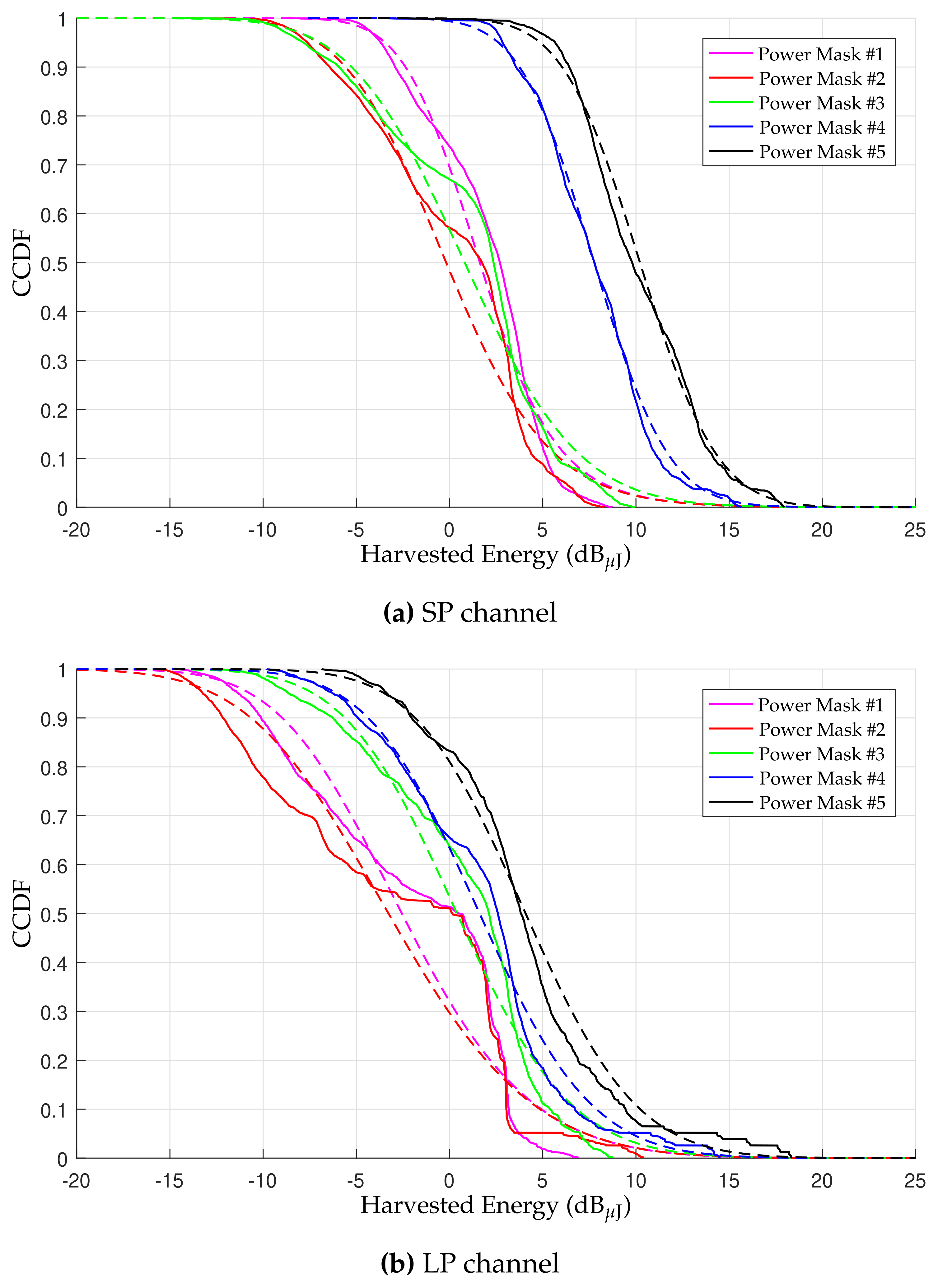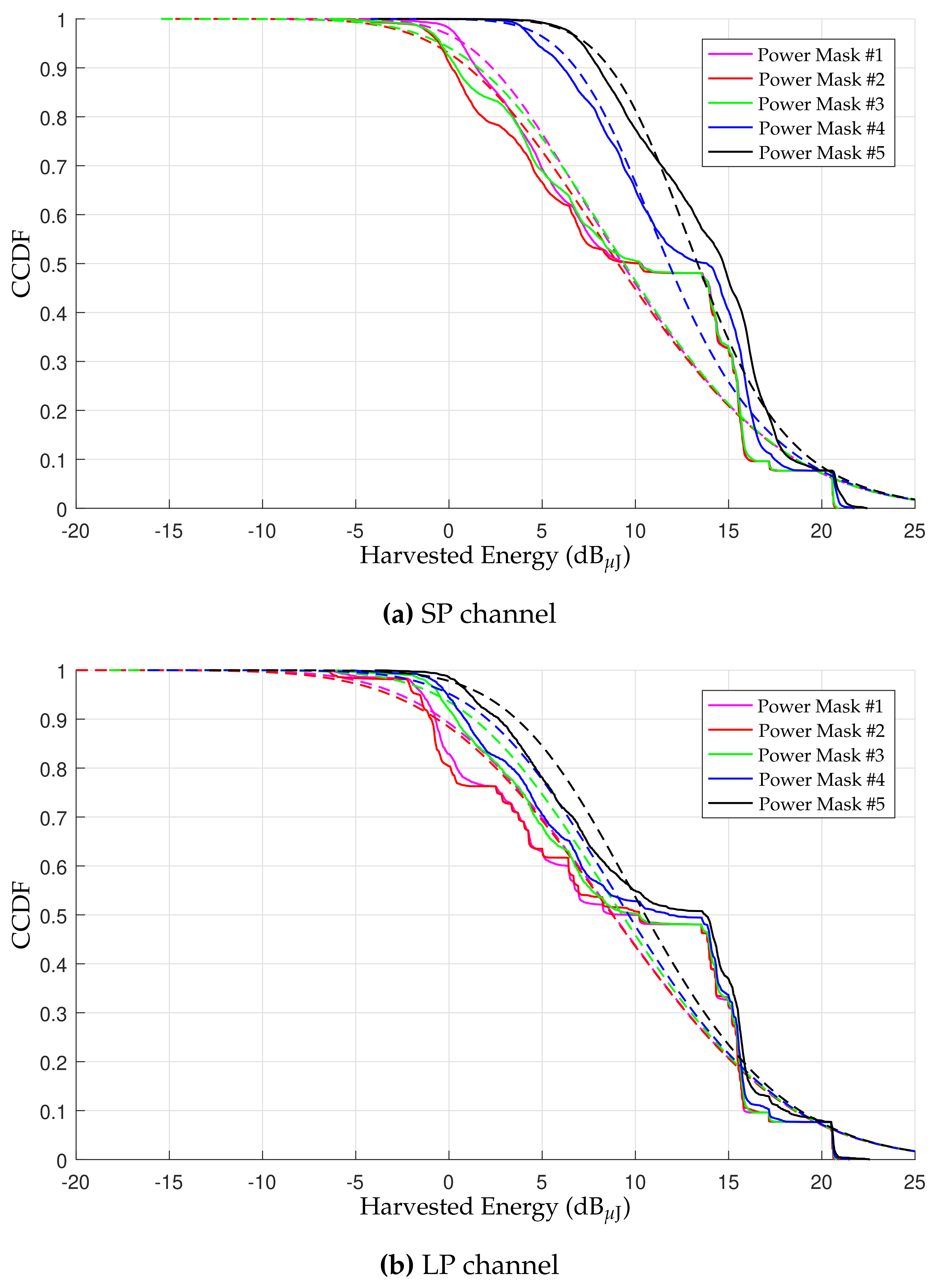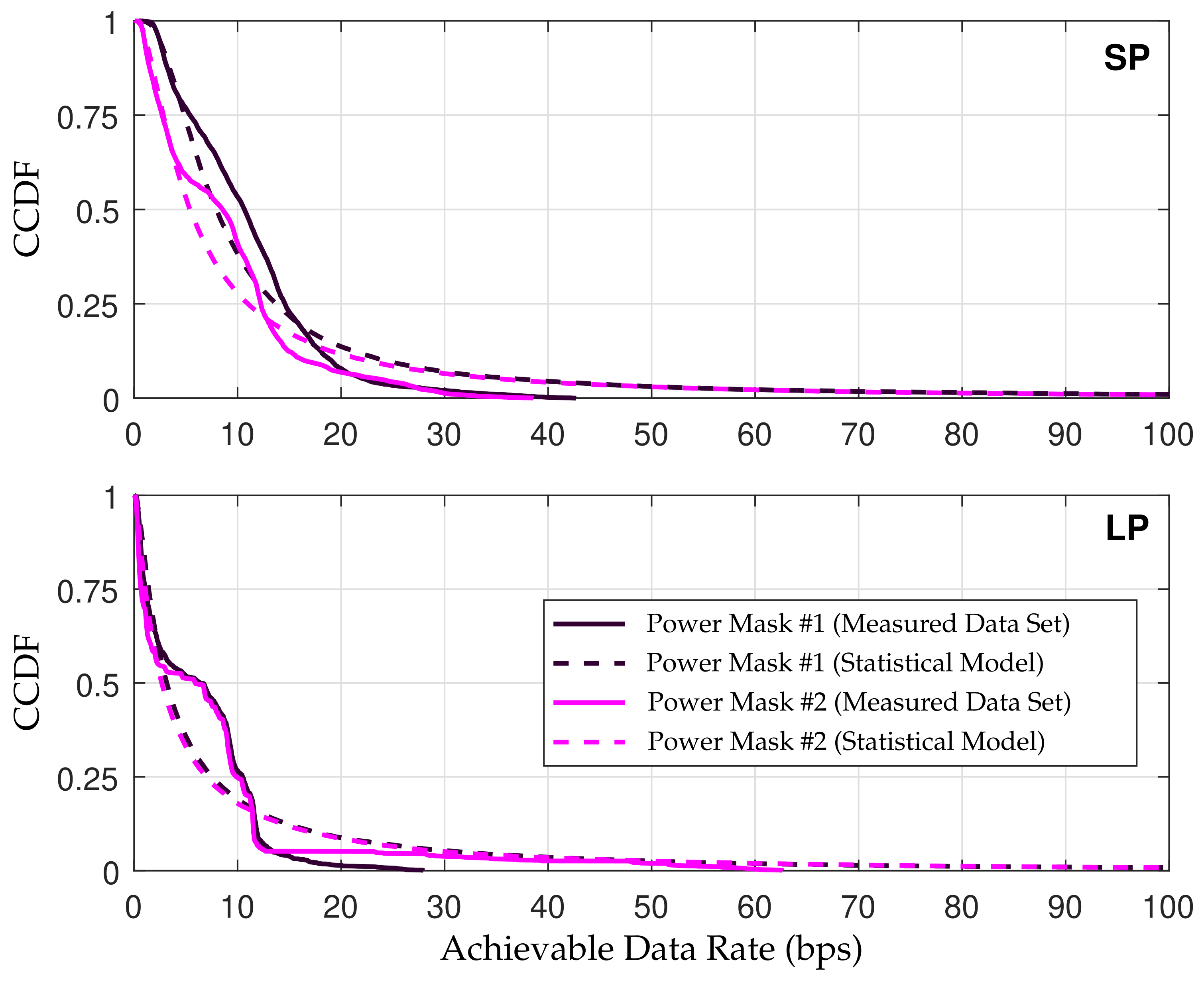The statistical modelings consist of fitting the harvested energy from the data set (CFRs and additive noises), assuming the five power masks and distinct values of both the transmission power and the overall efficiency factor, with a given statistical distribution such that its probability density function approximates the harvested energy’s histogram shape based on a certain statistic criterion. In other words, the parameters of each statistical distribution (i.e.,
) are varied, and the one with the maximum log-likelihood value (LLV) in relation to the histogram generated with the samples of the harvested energy is selected. The elements of the set of statistical distributions,
, were chosen in order to represent the statistical distributions that model random variables belonging to
and that are commonly used in the telecommunications field. Concerning the choice of fitting criterion, the maximization of LLV, often known as maximum likelihood estimation in its non-logarithmic form, is widely adopted in the literature [
19,
33,
34] because it is typically used as the strongest indication in comparison to other criteria such as the Akaike information criterion, the Bayesian information criterion, and the efficient determination criterion. Based on this discussion, the likelihood of parameters
for an independent and identically distributed random sample data set
is
in which
is the likelihood of parameters
for a single outcome
. Thus, the LLV is expressed as
In this regard,
Table 2,
Table 3 and
Table 4 list the highest LLVs for the harvested energy from the FoN received signal of hybrid SP PLC-WLC channels, hybrid LP PLC-WLC channels, and from the additive noises, respectively, when each statistical distribution in
is considered,
dBm, and
. With the exception of the WLC additive noise, the log-normal distribution yields the highest LLVs among the ones belonging to the
set. Concerning the WLC additive noise, it can be seen in
Table 4 that the LLV difference between beta and log-normal distributions is almost negligible. Mathematically, the difference between these values does not exceed
, which makes them very close approximations to each other. Although the beta distribution is the best-fitting distribution for the WLC additive noise, the log-normal distribution is easier to handle mathematically than the beta one, and, as a consequence, the log-normal distribution is used for the statistical modeling of the WLC additive noise. In this regard, the log-normal distribution is described by two parameters (
and
), and these parameters are directly related to its mean and variance [
35], respectively, by
and
By means of the LLVs in
Table 2,
Table 3 and
Table 4, one can conclude that the log-normal distribution yields the best representation of the harvested energy from FoN received signals and additive noises in hybrid PLC-WLC channels. In addition, the harvested energy from the total received signal (FoN received signal + additive noise) straightforwardly made the summation of these two distinct parts, and, consequently, it is modeled as the summation of these two log-normally distributed random variables. Mathematically, the total harvested energy from hybrid PLC-WLC channels during
is a random variable expressed as
in which
and
are random variables with log-normal distribution that model the harvested energy of the FoN received signal and additive noises during
, respectively. Furthermore,
is normally distributed with mean
and variance
, while
is normally distributed with mean
and variance
. Note that (
12) allows to easily obtain the total harvested energy of a WLC or PLC device, which is immersed in a environment characterized by hybrid PLC-WLC channels. This can be accomplished by substituting
q by
or
.
As expected, changing
and
only affects the amplitude of harvested energies. Therefore, for a given power mask,
does not change for distinct values of
and
. However, it is observed that there is a logarithmic relation between
and
as well as between
and
. Mathematically, for the harvested energy from the FoN received signal, this relation can be expressed as
where
is the value of transmission power in mW, and
represents the parameter
of a log-normal distribution when
mW and
. The parameters
are obtained by means of (
9) and are given in
Table 5 for the five distinct power masks and distinct channel distance ranges.
In the following,
Section 5.1 and
Section 5.2 detail two cases for the application of the presented statistical modeling. The first case assumes that a WLC device harvests energy from the total received signal that was transmitted by a PLC device, through the hybrid SP PLC-WLC channel, with Power Mask #2 and
dBm because the given power mask and the amount of transmission power are usually adopted by broadband-PLC devices. Additionally, a practical value of the overall efficiency factor for WLC device’s EH circuitry is used,
. The second case provides an evaluation of the harvested energy by a PLC device from the total received signal that was transmitted by a WLC device, through the hybrid LP PLC-WLC channel, using Power Mask #1 and
dBm because the chosen power mask and the value of transmission power are commonly adopted by WLC devices. Furthermore, the overall efficiency factor of the PLC device’s EH circuitry is expected to be low due to time-varying access impedance of electric power systems; thus,
is adopted.
5.3. Statistical Models versus Measured Data Set
Aiming to validate the statistical modelings, this subsection deals with the comparison between the CCDFs of harvested energies generated by statistical models and the CCDFs of harvested energies obtained from the measured data set. In this regard,
Figure 2a shows comparisons among CCDFs of harvested energies from the FoN received signal of a hybrid SP PLC-WLC channel (represented by continuous lines), which was calculated with the measured CFRs and CCDFs of the log-normally distributed random variable obtained from the statistical modeling of the FoN received signal (dashed lines). These plots assume the use of the five power masks,
dBm, and
, to illustrate an ideal case of the overall efficiency factor of the EH circuitry. Here, the harvested energies from the FoN received signal is modeled as a log-normally distributed random variable
, in which
, whereas
and
depend on the chosen power mask and the channel distance range and are both obtained from the first column in
Table 5. Under the same assumptions and for the hybrid LP PLC-WLC channel,
Figure 2b shows similar comparisons, where
and
are both obtained from the second column of
Table 5. By comparing these two figures, it is possible to see that CCDFs of statistical models are closer to CCDFs from the measured data set in hybrid SP PLC-WLC channels rather than in hybrid LP PLC-WLC channels due to the high variations of the magnitude of CFRs experienced by the latter. For instance, the highest discrepancy is noted in
Figure 2b for Power Mask #2, in which
dB
J of harvested energy results in a difference of
between the CCDFs of the statistical model and the measured data set.
Similarly,
Figure 3 shows a comparison between the CCDF of the harvested energies from WLC and PLC additive noises (continuous lines) and the CCDF of log-normally distributed random variables obtained from the statistical modeling of harvested energies from WLC and PLC additive noises (dashed lines) with
. These random variables are modeled as
, in which
and
are provided in the first and second lines of
Table 6 for the WLC and PLC additive noises, respectively. In this figure, a discrepancy is observed between CCDFs of harvested energies of statistical models and measured data set, which is in the worst case
(at 0 dB
J) and
(at
dB
J) for the WLC and PLC additive noises, respectively. It is important to emphasize that the impulsive components of the PLC additive noise may be responsible for increasing the inaccuracy between harvested energies from the statistical model and the measured data set due to its high amplitude values in relation to the background component, which makes the statistical modeling of it by a single random variable that is not extremely precise; however, the presented modeling is easily to mathematically handle, and it has a limited inaccuracy between the harvested energy obtained from the statistical model and the measured data set.
Figure 4a shows comparisons among CCDFs of the total harvested energies, which were calculated from the measured data set by a WLC device through a hybrid SP PLC-WLC channel (continuous lines) and CCDFs of random variables generated with the statistical modeling of these harvested energies (dashed lines). The random variables are the sum of two log-normally distributed random variables: one for the FoN received signal and one to the WLC additive noise. These plots are obtained with the five power masks,
dBm, and
because the chosen values represent a situation in which the PLC device operates with a typical value of transmission power, and the WLC device’s EH circuitry has an ideal overall efficiency factor. Under the same assumptions,
Figure 4b shows similar comparisons but assuming hybrid LP PLC-WLC channels. In both cases, the total harvested energy is modeled as a random variable
, where
and
in which
, whereas
and
depend on the chosen power mask and the channel distance range, and both are obtained from the first and second columns of
Table 5 for hybrid SP PLC-WLC and hybrid LP PLC-WLC channels, respectively, while
and
are taken from the first line of
Table 6.
From
Figure 4a, it is noticed that CCDFs of total harvested energies obtained from the measured data set and the statistical model are, in general, close to each other, except in some specific range of values in which a slight disagreement can occur. Additionally,
Figure 4b shows that total harvested energies of the statistical model and the measured data set present higher discrepancies in their CCDFs for Power Masks #1 and #2. For instance, Power Mask #2 has a good agreement at the harvested energies less than
dB
J, and a disagreement is noticed from
dB
J to 3 dB
J, in which the highest difference between the CCDFs is
and occurs when the total harvested energy is equal to 0 dB
J. As Power Masks #1 and #2 are the ones with the lowest EH performances among the considered power masks, it indicates that the lower is the contribution of the FoN received signal on the total harvested energy, the higher is the inaccuracy between total harvested energies of the statistical model and the measured data set.
Figure 5a shows comparisons among CCDFs of total harvested energies, obtained from measured data set, from a PLC device through the hybrid SP PLC-WLC channels (continuous lines) and the ones obtained from the statistical modeling (dashed lines). In these plots, the five distinct power masks,
dBm, and
are applied because the given parameters illustrate a situation in which the WLC device operates with a typical transmission power, and the EH circuitry of the PLC device has an ideal overall efficiency factor. Regarding hybrid LP PLC-WLC channels,
Figure 5b shows similar comparisons. Here, the total harvested energy is modeled as a random variable equal to
, where
and
in which
, whereas
and
are both obtained from the first and second columns of
Table 5 for hybrid SP PLC-WLC and hybrid LP PLC-WLC channels, respectively, while
and
are taken from the second line of
Table 6.
By means of
Figure 5a, it is clear that the lower is the contribution of the FoN received signal to the total harvested energy, the higher is the discrepancy between the CCDFs of total harvested energies of the statistical model and the measured data set. This can be observed in Power Masks #1 to #4 and almost not seen in Power Mask #5 because Power Mask #5 yields the highest contributions of the FoN received signal to the total harvested energy. In the worst case, the difference between the total harvested energy from the measured data set and the statistical model occurs in
Figure 5b, and it is
, at the point in which the total harvested energy is equal to
dB
J for Power Mask #2.
Given this discussion, the characteristic that mostly affects the statistical modeling accuracy is related to the decreasing of the harvested energy from the FoN received signal in relation to the additive noise, which can be caused by: (i) reducing , (ii) the use of a power mask that takes worse advantage of , and (iii) the use of higher distance ranges in hybrid PLC-WLC channels (i.e., LP channels instead of SP ones). Although the CCDFs of the statistical model have discrepancies with the ones from the measured data set when the highlighted characteristic occurs, the difference between them is expected since no statistical model has an excellent match to capture the complete behavior of the measured data set. Additionally, the difference between the CCDFs of the statistical models and the measured data set is not relevant, and it is limited, in the worst case, by assuming typical values of , yielding a good agreement between them. Furthermore, if W (i.e., ambient EH approach), then the highest discrepancy is one of the additive noises, for the WLC and for the PLC, because there is no FoN received signal. On the other hand, if , then the highest discrepancy is the one observed in the FoN received signal, which is for Power Mask #2 and hybrid LP PLC-WLC channels, because the additive noises yield irrelevant amounts of harvested energy in comparison to the FoN received signal under this condition.
Aiming to validate the statistical model,
Figure 6 shows a numerical comparison between the CCDF of achievable data rates obtained in Scenario #1 for Power Masks #1 and #2, with
dBm and
, when measured data set (continuous line) and the proposed statistical model (dashed line) are used to generate the total harvested energy values. These values are applied in Equation (
8) of [
24] in order to obtain the achievable data rates. Additionally, the chosen scenario represents an interesting possibility of IoT application due to its high relation to low-power radio-frequency WLC device, which is commonly used in wireless sensors network for making each electronic device communicating to another. According to Subsection F of [
24], Scenario #1 is described as follows: a WLC (EH) device harvests its energy from the hybrid PLC-WLC channel and, thus, realizes a data communication with another low-power radio-frequency WLC device at one of the unlicensed industrial, scientific, and medical frequency bands, which is centered at
GHz, with a frequency bandwidth of 500 kHz. It is assumed that the WLC device is consecutively communicating and harvesting energy, such that it uses half of the time for EH and the other half for data communication.
In
Figure 6, it can be seen that the same inaccuracy observed between CCDFs of total harvested energies of the statistical model and the measured data set in
Figure 4 and
Figure 5 are also noticed between CCDFs of achievable data rates when the total harvested energies, used for data communication, are obtained from the statistical model and the measured data set. In other words, the total harvested energy from the statistical model is in good agreement with the one obtained from the measured data set, and it is also seen in the CCDF of achievable data rates. Therefore, the statistical models have made the harvested energies a generic and an easy-to-simulate feature for any value of
,
, for five distinct power masks, and for two different regions that are associated with distinct distances of the WLC device from the power line (i.e., SP and LP channels), which can be used to perform data communications.
